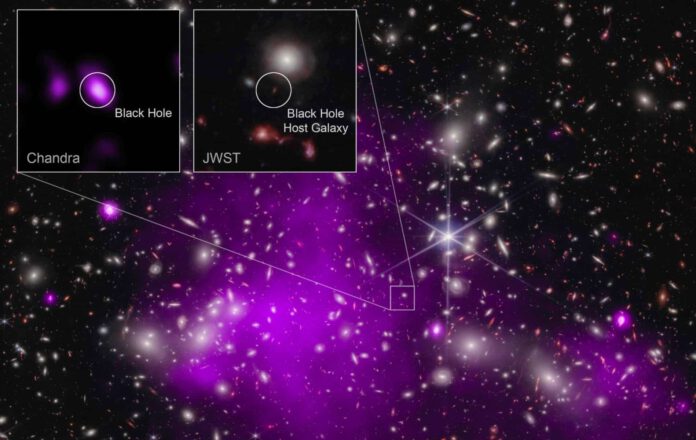
The black hole is located at an impressive distance of approximately 13.2 billion light-years from Earth, and stands out due to its considerable weight, despite having formed shortly after the big bang. Notably, the weight of this young black hole surpasses that of its host galaxy, marking a phenomenon previously unseen by researchers.
The Discovery of the Black Hole
The discovery of this remarkable black hole is attributed to the excellent cooperation of two high-powered telescopes. These instruments alone however were not able to detect the distant galaxy and its unique resident black hole. Thanks to the assistance of a cluster of galaxies, named Abell 2744 and located about 3.5 billion light-years from Earth, it was possible. This cluster acted as a gravitational lens, bending and amplifying the light emanating from the distant galaxy, which allowed the James Webb space telescope to spot the otherwise elusive black hole. The Chandra X-ray Observatory, again with the help of the gravitational lensing effect, detected the X-rays revealing the presence of a supermassive black hole within the galaxy.
The Peculiar Attributes of the Black Hole
The black hole in question is located within a galaxy about 13.2 billion light-years away from Earth. The light that had reached us from this galaxy reveals both the galaxy and the black hole as they were roughly 470 million years after the big bang. Despite its young age, the black hole is estimated to be 10 to 100 million times heavier than our own Sun, according to the brightness and energy of the X-ray radiation it emits. That makes it approximately as heavy as all the stars in its galaxy, a very unusual observation. For context, black holes found within galaxy centers closer to us generally have a mass equivalent to only 0.1 percent of the mass of the stars in their respective galaxies.
Understanding the Origin of Black Holes
This unusually heavy black hole observed in the young universe is of great interest to astronomers. Previous observations had already indicated the existence of supermassive black holes in the early ages of the universe. However, such a heavy black hole spotted early on in the universe’s history is a new discovery. “This is one of the most dramatic discoveries of the James Webb Space Telescope,” asserts Michael Strauss, professor of astrophysics at Princeton University, who was not involved in the research. “This is the furthest-growing supermassive black hole known to us so far. And it completely shatters the old record.”
Two possible formations for such supermassive black holes have been established. The first theory proposes a large birth weight, as when colossal gas clouds collapse. This potential scenario would result in newborn black holes being between 10,000 and 100,000 times heavier than our sun. The second theory involves the explosion of the first stars, resulting in relatively smaller newborn black holes, which will subsequently grow. This scenario produces newborn black holes only 10 to 100 times heavier than our Sun.
The Fast-Growing Black Hole
The black hole in question, having already achieved a substantial weight only 470 million years after the big bang, suggests that it did not have enough time to grow but was already enormous to begin with. This observation is akin to discovering a toddler weighing 200 kilos. Researcher Andy Goulding suggests, “Discovering a black hole that was already this big when the universe was still very young, tells us that this black hole must have been very large at its birth.”
The “Outsize Black Hole”
The mass of the black hole, coupled with its young age and the quantity of X-ray radiation it emits, hint that it is an ‘Outsize Black Hole’. This term was coined in 2017 to represent black holes in the young universe that originate from collapsing, large gas clouds and are thus significantly large at birth. Their existence was only hypothetical until recent findings provided tangible evidence. Researcher Priyamvada Natarajan believes, “We think we have now detected such an Outsize Black Hole for the first time.” It offers the best evidence so far that some black holes are formed from massive gas clouds, allowing us to view for the first time a supermassive black hole in that brief stage before its growth lags, where it weighs about the same as the stars in its galaxy.
Continued Research is Needed
While this singular black hole suggests some supermassive black holes in the young universe had a head start and were heavy at birth, further research is certainly required. Only with additional observations of significantly massive black holes that were formed shortly after the big bang can researchers conclusively understand the formation of the very first supermassive black holes. Nevertheless, this discovery has sparked optimism regarding the possibility of finding more of these sizeable newborn black holes in the early universe using a combination of different telescopes and observatories.











